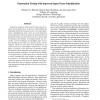Free Online Productivity Tools
i2Speak
i2Symbol
i2OCR
iTex2Img
iWeb2Print
iWeb2Shot
i2Type
iPdf2Split
iPdf2Merge
i2Bopomofo
i2Arabic
i2Style
i2Image
i2PDF
iLatex2Rtf
Sci2ools
ICST
2009
IEEE
2009
IEEE
Penetration Testing with Improved Input Vector Identification
Penetration testing is widely used to help ensure the security of web applications. It discovers vulnerabilities by simulating attacks from malicious users on a target application. Identifying the input vectors of a web application and checking the results of an attack are important parts of penetration testing, as they indicate where an attack could be introduced and whether an attempted attack was successful. Current techniques for identifying input vectors and checking attack results are typically ad-hoc and incomplete, which can cause parts of an application to be untested and leave vulnerabilities undiscovered. In this paper, we propose a new approach to penetration testing that addresses these limitations by leveraging two recentlydeveloped analysis techniques. The first is used to identify a web application's possible input vectors, and the second is used to automatically check whether an attack resulted in an injection. To empirically evaluate our approach, we compare it ...
| Added | 19 Feb 2011 |
| Updated | 19 Feb 2011 |
| Type | Journal |
| Year | 2009 |
| Where | ICST |
| Authors | William G. J. Halfond, Shauvik Roy Choudhary, Alessandro Orso |
Comments (0)

